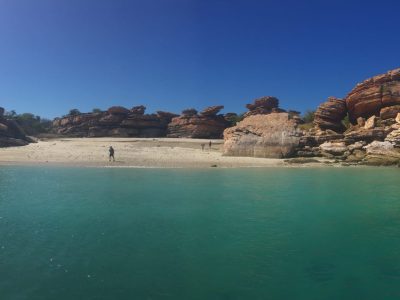Australian Coastal Systems: A New Book from Andy Short

Montesquieu Islands, Western Australia
Recently I received a copy of a book written by Andy Short entitled Australian Coastal Systems: Beaches, Barriers and Compartments (2019, Springer, Coastal Reference Library 32). It has been produced as a two-volume set containing 1241 pages, 550 figures and over 1000 references. The work is dedicated to all who have worked and published on the Australian coast.
Andy invited me to write the Foreword. I feel very privilege to have been asked as it provided me with an opportunity to place this magnificent study into context. Whilst it offered Andy an opportunity to bring together his incredible efforts at collecting and synthesising information about our coast, it also arose out of a need by the then Australian Government for a better understanding of the dynamic nature of different coastal systems in order to assist those with responsibilities to manage those systems. This need led to support for NCCARF to undertake a detailed national study of coastal sediment compartments. A project was initiated as part of CoastAdapt embedded within the Shoreline Explorer module. With the termination of that work, Andy took it upon himself to couple his extensive field knowledge of the entire Australian coast with that of others to write this book which greatly expands on that module. It is a two-year labour of love, incredible dedication and outstanding scholarship.
The book provides information for a wide audience; essentially “for anyone who wants to know more about any part of our vast coastline”. Those words “any part” are the key to this book. It is a recording of what we know about the coast in 2019 with its focus on beaches, barriers and sediment compartments. To achieve this purpose, he has very systematically organised presentation following a hierarchical classification of the Australian coast into provinces, divisions, regions then into primary, secondary and tertiary compartments. Besides the very useful background information, focus is on describing characteristics of the 354 secondary compartments. Each compartment is numbered and placed within the hierarchical classification. Because of the amount of material gathered for publication, there are two volumes, Volume 1 covers the coast from the Pilbara around the top end and then down the east coast through Queensland into central NSW. Volume 2 commences on the NSW coast south from Cape Hawke around the southern coast including Tasmania and across the south and up the WA coast to Exmouth.
Although the book is full of descriptions and references for each secondary compartment, it also has very important material on the evolution and dynamics of the Australian coast. This is important given variability in geologic and climatic conditions that help define the conditions of the various compartments. In this way we are able to readily see how geographic and geomorphic factors function around the coast. He is able to document in detail the varying nature of barrier, beach and sediment types. Details are presented in the numerous illustrations. What is most impressive are the array of photos used to depict present-day conditions. High-quality aerial images are used for most compartments.
Andy has offered us a major contribution to coastal science. It is a baseline work that will serve for years ahead to highlight how our coastal areas change whether they be in populated areas or not. In this way we can see what impacts of natural and human forces will have at a scale that relates to all interested in our coast. Already coastal policy at a state level is using the sediment compartment approach to greater effect than in the past. This book should reinforce that interest. As said above, it is magnifique.
Bruce Thom
Words by Prof Bruce Thom. Please respect the author’s thoughts and reference appropriately: (c) ACS, 2019, for correspondence about this blog post please email austcoastsoc@gmail.com
#152


 South Australian 2019 Coastal Conference and the ACS AGM
South Australian 2019 Coastal Conference and the ACS AGM